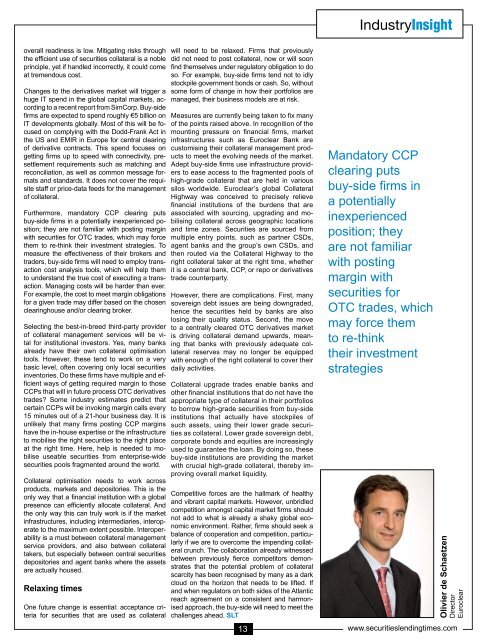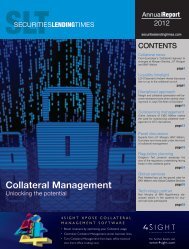read - Securities Lending Times
read - Securities Lending Times
read - Securities Lending Times
Create successful ePaper yourself
Turn your PDF publications into a flip-book with our unique Google optimized e-Paper software.
IndustryInsight<br />
overall <strong>read</strong>iness is low. Mitigating risks through<br />
the efficient use of securities collateral is a noble<br />
principle, yet if handled incorrectly, it could come<br />
at tremendous cost.<br />
Changes to the derivatives market will trigger a<br />
huge IT spend in the global capital markets, according<br />
to a recent report from SimCorp. Buy-side<br />
firms are expected to spend roughly €5 billion on<br />
IT developments globally. Most of this will be focused<br />
on complying with the Dodd-Frank Act in<br />
the US and EMIR in Europe for central clearing<br />
of derivative contracts. This spend focuses on<br />
getting firms up to speed with connectivity, presettlement<br />
requirements such as matching and<br />
reconciliation, as well as common message formats<br />
and standards. It does not cover the requisite<br />
staff or price-data feeds for the management<br />
of collateral.<br />
Furthermore, mandatory CCP clearing puts<br />
buy-side firms in a potentially inexperienced position;<br />
they are not familiar with posting margin<br />
with securities for OTC trades, which may force<br />
them to re-think their investment strategies. To<br />
measure the effectiveness of their brokers and<br />
traders, buy-side firms will need to employ transaction<br />
cost analysis tools, which will help them<br />
to understand the true cost of executing a transaction.<br />
Managing costs will be harder than ever.<br />
For example, the cost to meet margin obligations<br />
for a given trade may differ based on the chosen<br />
clearinghouse and/or clearing broker.<br />
Selecting the best-in-breed third-party provider<br />
of collateral management services will be vital<br />
for institutional investors. Yes, many banks<br />
al<strong>read</strong>y have their own collateral optimisation<br />
tools. However, these tend to work on a very<br />
basic level, often covering only local securities<br />
inventories. Do these firms have multiple and efficient<br />
ways of getting required margin to those<br />
CCPs that will in future process OTC derivatives<br />
trades? Some industry estimates predict that<br />
certain CCPs will be invoking margin calls every<br />
15 minutes out of a 21-hour business day. It is<br />
unlikely that many firms posting CCP margins<br />
have the in-house expertise or the infrastructure<br />
to mobilise the right securities to the right place<br />
at the right time. Here, help is needed to mobilise<br />
useable securities from enterprise-wide<br />
securities pools fragmented around the world.<br />
Collateral optimisation needs to work across<br />
products, markets and depositories. This is the<br />
only way that a financial institution with a global<br />
presence can efficiently allocate collateral. And<br />
the only way this can truly work is if the market<br />
infrastructures, including intermediaries, interoperate<br />
to the maximum extent possible. Interoperability<br />
is a must between collateral management<br />
service providers, and also between collateral<br />
takers, but especially between central securities<br />
depositories and agent banks where the assets<br />
are actually housed.<br />
Relaxing times<br />
One future change is essential: acceptance criteria<br />
for securities that are used as collateral<br />
will need to be relaxed. Firms that previously<br />
did not need to post collateral, now or will soon<br />
find themselves under regulatory obligation to do<br />
so. For example, buy-side firms tend not to idly<br />
stockpile government bonds or cash. So, without<br />
some form of change in how their portfolios are<br />
managed, their business models are at risk.<br />
Measures are currently being taken to fix many<br />
of the points raised above. In recognition of the<br />
mounting pressure on financial firms, market<br />
infrastructures such as Euroclear Bank are<br />
customising their collateral management products<br />
to meet the evolving needs of the market.<br />
Adept buy-side firms use infrastructure providers<br />
to ease access to the fragmented pools of<br />
high-grade collateral that are held in various<br />
silos worldwide. Euroclear’s global Collateral<br />
Highway was conceived to precisely relieve<br />
financial institutions of the burdens that are<br />
associated with sourcing, upgrading and mobilising<br />
collateral across geographic locations<br />
and time zones. <strong>Securities</strong> are sourced from<br />
multiple entry points, such as partner CSDs,<br />
agent banks and the group’s own CSDs, and<br />
then routed via the Collateral Highway to the<br />
right collateral taker at the right time, whether<br />
it is a central bank, CCP, or repo or derivatives<br />
trade counterparty.<br />
However, there are complications. First, many<br />
sovereign debt issues are being downgraded,<br />
hence the securities held by banks are also<br />
losing their quality status. Second, the move<br />
to a centrally cleared OTC derivatives market<br />
is driving collateral demand upwards, meaning<br />
that banks with previously adequate collateral<br />
reserves may no longer be equipped<br />
with enough of the right collateral to cover their<br />
daily activities.<br />
Collateral upgrade trades enable banks and<br />
other financial institutions that do not have the<br />
appropriate type of collateral in their portfolios<br />
to borrow high-grade securities from buy-side<br />
institutions that actually have stockpiles of<br />
such assets, using their lower grade securities<br />
as collateral. Lower grade sovereign debt,<br />
corporate bonds and equities are increasingly<br />
used to guarantee the loan. By doing so, these<br />
buy-side institutions are providing the market<br />
with crucial high-grade collateral, thereby improving<br />
overall market liquidity.<br />
Competitive forces are the hallmark of healthy<br />
and vibrant capital markets. However, unbridled<br />
competition amongst capital market firms should<br />
not add to what is al<strong>read</strong>y a shaky global economic<br />
environment. Rather, firms should seek a<br />
balance of cooperation and competition, particularly<br />
if we are to overcome the impending collateral<br />
crunch. The collaboration al<strong>read</strong>y witnessed<br />
between previously fierce competitors demonstrates<br />
that the potential problem of collateral<br />
scarcity has been recognised by many as a dark<br />
cloud on the horizon that needs to be lifted. If<br />
and when regulators on both sides of the Atlantic<br />
reach agreement on a consistent and harmonised<br />
approach, the buy-side will need to meet the<br />
challenges ahead. SLT<br />
13<br />
Mandatory CCP<br />
clearing puts<br />
buy-side firms in<br />
a potentially<br />
inexperienced<br />
position; they<br />
are not familiar<br />
with posting<br />
margin with<br />
securities for<br />
OTC trades, which<br />
may force them<br />
to re-think<br />
their investment<br />
strategies<br />
Olivier de Schaetzen<br />
Director<br />
Euroclear<br />
www.securitieslendingtimes.com












